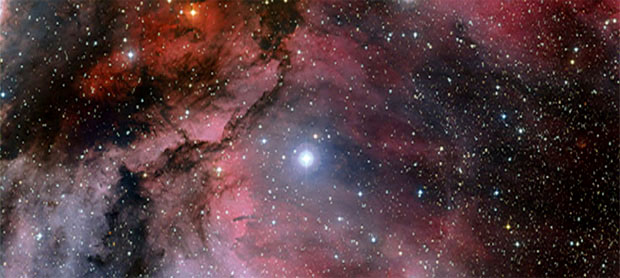|

by Stephen Smith
January 25, 2011
from
Thunderbolts Website

Close up image of the
Carina Nebula, with its bright star WR 22.
Credit: European Southern Observatory.
Astronomers do not know why some stars
shed their atmospheres at a furious rate.
For many years, astrophysical models of stellar evolution have
relied on mechanical action. The forces that shape them have been
attributed to the collapse of cold gas under gravitational
influence. Common viewpoints see stars as whirling vortices of
compressed matter heated to fusion temperatures by pressure, alone.
Compression, it is said, draws clouds of gas and dust a thousand
times less dense than a puff of smoke into a region of increased
density that coaxes even more material to collect there. Eventually,
the atoms within the cloud can no longer resist the inward
attraction and they fall into the well of nuclear fusion, initiating
a self-sustaining reaction.
According to consensus opinions about stars, those that are
extremely massive live fast and die young.
They rapidly "fuse" their
hydrogen and helium into heavier elements that, in turn, fuse into
ones that are heavier still. In their senescence, the radiative
emissions from such stars are thought to be so intense that they
"blow away" enormous quantities of stellar material. In some cases,
they lose mass up to a million times faster than our own Sun.
However, that process is highly
speculative.
The
Electric Star hypothesis resolves many of the distorted
opinions that arise when astronomers misunderstand the role of
plasma and electric fields in space. Rather than gravity and kinetic
activity (heated gas), radiant emanations result from electric
currents. More powerful electric flux results in more powerful
energetic output.
Electric discharges in plasma clouds create double layers, or
sheaths, along their current axes. Positive charge builds up on one
side and negative charge on the other. An electric field develops
between the sides, and if enough current is applied, the sheath
glows; otherwise it is invisible.
When electric currents flow along the sheaths, the currents spiral
into filaments. The filaments attract each other, but rather than
merging, they form zones of enormous compressive force known as
z-pinches. Arc mode discharges might occur. Gravity, although it
plays a small role in stellar evolution, is far too weak a force
when compared to electric fields in plasma.
Since astronomers do not map
the current flow through space, or
consider its influence on stellar evolution, they overstate the case
for gravitational models. The electrical input and output of the
stars is not considered when theories are debated. By failing to
give it credence, an entire line of investigation remains fallow.
Retired professor of electrical engineering Don Scott
provided a new look at stars in his book
The Electric Sky. Scott
suggests that mass, temperature, and luminosity are not the only
factors that should be considered when describing a star's life
cycle.
The most important factor is the current
density in Amperes per square meter (A/m2) at the star's surface.
If the incoming current density increases, a star's surface gets
hotter, radiates shorter wavelengths, and becomes brighter.
Therefore, the strength of the impinging current density, as well as
diameter, are responsible for a star's absolute brightness.
Massive stars might not be so massive after all.
The intense radiation that is
interpreted as an "atmosphere blowing away" is most likely due to
high input currents triggering frequent bursts of stellar lightning.
What appears to be a giant star might be a relatively small star
with a large coma structure that is emitting a torrent of charged
particles.
Whether such stars live short or long
lives has nothing to do with their gravitational mass.
|

